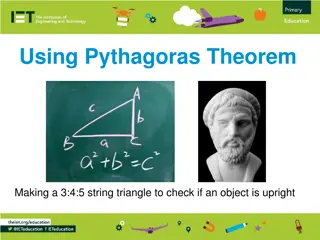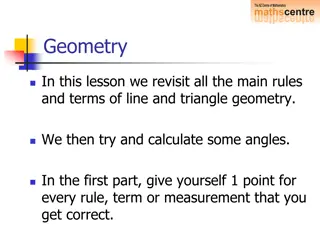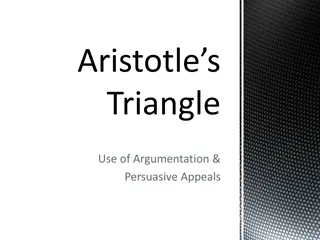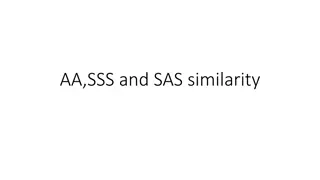Triangle Areas
How to calculate the areas of different types of triangles – right-angled, isosceles, and scalene – by understanding their unique properties and relationships with rectangles. Discover formulas for each type to easily compute their areas.
Download Presentation

Please find below an Image/Link to download the presentation.
The content on the website is provided AS IS for your information and personal use only. It may not be sold, licensed, or shared on other websites without obtaining consent from the author.If you encounter any issues during the download, it is possible that the publisher has removed the file from their server.
You are allowed to download the files provided on this website for personal or commercial use, subject to the condition that they are used lawfully. All files are the property of their respective owners.
The content on the website is provided AS IS for your information and personal use only. It may not be sold, licensed, or shared on other websites without obtaining consent from the author.
E N D
Presentation Transcript
Review IMGD 2905
What are two main types of data for game analytics?
What are two main types of data for game analytics? Quantitative objective data from the game, often from instrumention (code to write/log data), typically players playing the game Qualitative subjective evaluation, typically from players during or after gameplay
What steps are in the game analytics pipeline?
What steps are in the game analytics pipeline? Game (instrumented) Data (collected from players playing game) Extracted data (e.g., from scripts) Analysis Statistics, Charts, Tests Dissemination Report Talk, Presentation
What is population versus sample? Population all members of group pertaining to study Typically want parameter of this group Sample part of population selected for analysis Typically compute statistic to estimate parameter
What is probability sampling? Probability sampling selecting members from the population group while considering the likelihood of selection Likelihood as part of population
What is a Variable in Statistics? Any characteristics that can be measured, classified or counted Examples: age, eye color, income, high score, kill- death ratio, vehicle type e.g., time spent in competitive mode in Starcraft 2 e.g., vehicle choice in Grand Theft Auto (GTA) Player Hours Champ A 2 B 7.5 Leona Teemo Variables in columns Independent variable is inherent in population, versus dependent variable that want to assess
What is a Pareto chart? When used? Bar chart, arranged most to least frequent Line showing cumulative percent https://goo.gl/S7qDTJ Helps identify most common, relative amounts
When should you not use pie chart? When too many slices (more than 3) When comparing sizes of slices/wedges http://cdn.arstechnica.net/FeaturesByVersion.png
When should you not use pie chart? (Often) when comparing pies
What is a heat map? Describe an example Map where data represented as colors Typically, greater values brighter intensity colors
Provide three guidelines for good charts 1. Require minimum effort from reader 2. Maximize information 3. Minimize ink 4. Use commonly accepted practices 5. Avoid ambiguity
Which Measure of Central Tendency to Use? Why?
What are Quartiles? Three values that divide population into four equal sized groups
Describe how to Compute Variance 1. Compute mean. 2. Take a sample and compute how far it is from mean. Square this. 3. Repeat #2 for each sample. 4. Add up all. 5. Divide by number of samples (-1).
What is Mendenhalls Empirical Rule? https://mathbitsnotebook.com/Algebra1/StatisticsData/normalgrapha.jpg
What can you interpret from Z-score? Z1 = 0.5? Z2 = -3.2? How unusual a score is Where (above or below) score is relative to the average (mean) and spread (std dev) Z2 Z1
In Probability, what is an Exhaustive Set of Events? Give an Example. A set of all possible outcomes of an experiment or observation e.g., coin: events {heads, tails} e.g., d6: events {even number, odd number} e.g., picking Champion in LoL: events {Shen, Teemo, Leona, } (all possible Champions listed)
What Numeric Values do Probabilities take? (Hint: we had two rules) Probabilities must be between 0 and 1 (but often written/said as percent) Probabilities of set of exhaustive, mutually exclusive events must add up to 1
Probability Draw 1 card. What is the probability drawing a Jack? Poll 1! https://web.cs.wpi.e du/~imgd2905/d22/ polls.html
Probability Draw 1 card. What is the probability drawing a Jack? P(J) = 2 favorable outcomes / 5 total outcomes = 2/5
Probability Draw 2 cards simultaneously. What is the probability of drawing 2 Jacks? Poll 2! https://web.cs.wpi.e du/~imgd2905/d22/ polls.html
Probability Draw 2 cards simultaneously. What is the probability of drawing 2 Jacks? P(2J) = P(J) x P(J | J) = 2/5 x 1/4 = 1/10
Probability Draw 3 cards simultaneously. What is the probability of not drawing at least 1 King? Poll 3! https://web.cs.wpi.e du/~imgd2905/d22/ polls.html
Probability Draw 3 cards simultaneously. What is the probability of not drawing at least 1 King? P(K ) x P(K | K ) x P(K | K K ) = 3/5 x 2/4 x 1/3 = 6/60 = 1/10
What Kind of Probability Distribution is: Rolling one 6-sided dice (d6)? Can you draw it? Uniform (or square ) http://tinyurl.com/y4j5u64d Number of 1s when rolling 20 4-sided dice (d4)? Binomial http://statistics.wikidot.com/local--files/ch6/binomial.png
What Kind of Probability Distribution is: Rolling one 6-sided dice (d6)? Can you draw it? Uniform (or square ) http://tinyurl.com/y4j5u64d Number of 1s when rolling 20 4-sided dice (d4)? Can you draw it? Binomial http://statistics.wikidot.com/local--files/ch6/binomial.png
What Kind of Probability Distribution is: Rolling one 6-sided dice (d6)? Can you draw it? Uniform (or square ) http://tinyurl.com/y4j5u64d Number of 1s when rolling 20 4-sided dice (d4)? Can you draw it? Binomial http://statistics.wikidot.com/local--files/ch6/binomial.png
What are the characteristics of an experiment with a binomial distribution of outcomes?
What are the characteristics of an experiment with a binomial distribution of outcomes? Experiment consists of n independent, identical trials Each trial results in only success or failure (probability p for success for each) Random variable of interest (X) is number of successes in n trials http://www.vassarstats.net/textbook/f0603.gif
What are the characteristics of an experiment with a Poisson distribution of outcomes?
What are the characteristics of an experiment with a Poisson distribution of outcomes? 1. Interval (e.g., time) with units Probability of event same for all interval units Number of events in one unit independent of others Events occur singly (not simultaneously) Random variable of interest (X) is number of events that occur in an interval http://methods.sagepub.com/images/virtual/encyc-of-research-design/p1043-1.jpg 2. 3. 4. 5. Phrase people use is random arrivals
Expected Value What is the formula for expected value? x = E(X) = ???
Expected Value What is the formula for expected value? x = E(X) = x1P(x1) + x2P(x2) + + xnP(xn)
Expected Value What is the formula for expected value? Toss: Flip 2 coins Each Head gives 1 point 2 Tails bust, turn over x = E(X) = x1P(x1) + x2P(x2) + + xnP(xn)
Expected Value What is the formula for expected value? Toss: Flip 2 coins Each Head gives 1 point 2 Tails bust, turn over x = E(X) = x1P(x1) + x2P(x2) + + xnP(xn) What is the expected value after 1 toss? Poll!
Expected Value What is the formula for expected value? Toss: Flip 2 coins Each Head gives 1 point 2 Tails bust, turn over x = E(X) = x1P(x1) + x2P(x2) + + xnP(xn) What is the expected value after 1 toss? E(X) = 0*P(TT) + 1*P(HT) + 1*P(TH) + 2*P(HH) = 1/4 + 1/4 + 2/4 = 4/4 = 1
Expected Value What is the formula for expected value? Toss: Flip 2 coins Each Head gives 1 point 2 Tails bust, turn over x = E(X) = x1P(x1) + x2P(x2) + + xnP(xn) What is the expected value after 1 toss? E(X) = 0*P(TT) + 1*P(HT) + 1*P(TH) + 2*P(HH) = 1/4 + 1/4 + 2/4 = 4/4 = 1 E(X) = x1P(bust) + x2P(bust ) After 2 tosses?
Expected Value What is average if don t bust? A = HT + TH + HH = (1 + 1 + 2) / 3 = 4/3 Poll! Toss: Flip 2 coins Each Head gives 1 point 2 Tails bust, turn over What is the expected value after 1 toss? E(X) = P(TT) * 0 + (1- P(TT)) * 4/3 = * 4/3 = 1 2 tosses? E(X) = (1-P(TT))2 * (4/3 * 2) = * * 8/3 = 1.5 3 tosses? E(X) = (1-P(TT))3 * (4/3 * 3) = * * * 12/3 = 1.6875 BEST_BOT?
Expected Value What is average if don t bust? A = HT + TH + HH = (1 + 1 + 2) / 3 = 4/3 Toss: Flip 2 coins Each Head gives 1 point 2 Tails bust, turn over What is the expected value after 1 toss? E(X) = P(TT) * 0 + (1- P(TT)) * 4/3 = * 4/3 = 1 2 tosses? E(X) = (1-P(TT))2 * (4/3 * 2) = * * 8/3 = 1.5 3 tosses? E(X) = (1-P(TT))3 * (4/3 * 3) = * * * 12/3 = 1.6875 Poll! BEST_BOT?
Expected Value What is average if don t bust? A = HT + TH + HH = (1 + 1 + 2) / 3 = 4/3 Toss: Flip 2 coins Each Head gives 1 point 2 Tails bust, turn over What is the expected value after 1 toss? E(X) = P(TT) * 0 + (1- P(TT)) * 4/3 = * 4/3 = 1 2 tosses? E(X) = (1-P(TT))2 * (4/3 * 2) = * * 8/3 = 1.5 3 tosses? E(X) = (1-P(TT))3 * (4/3 * 3) = * * * 12/3 = 1.6875 BEST_BOT?
Expected Value What is average if don t bust? A = HT + TH + HH = (1 + 1 + 2) / 3 = 4/3 Toss: Flip 2 coins Each Head gives 1 point 2 Tails bust, turn over What is the expected value after 1 toss? E(X) = P(TT) * 0 + (1- P(TT)) * 4/3 = * 4/3 = 1 2 tosses? E(X) = (1-P(TT))2 * (4/3 * 2) = * * 8/3 = 1.5 3 tosses? E(X) = (1-P(TT))3 * (4/3 * 3) = * * * 12/3 = 1.6875 Poll! BEST_BOT?























